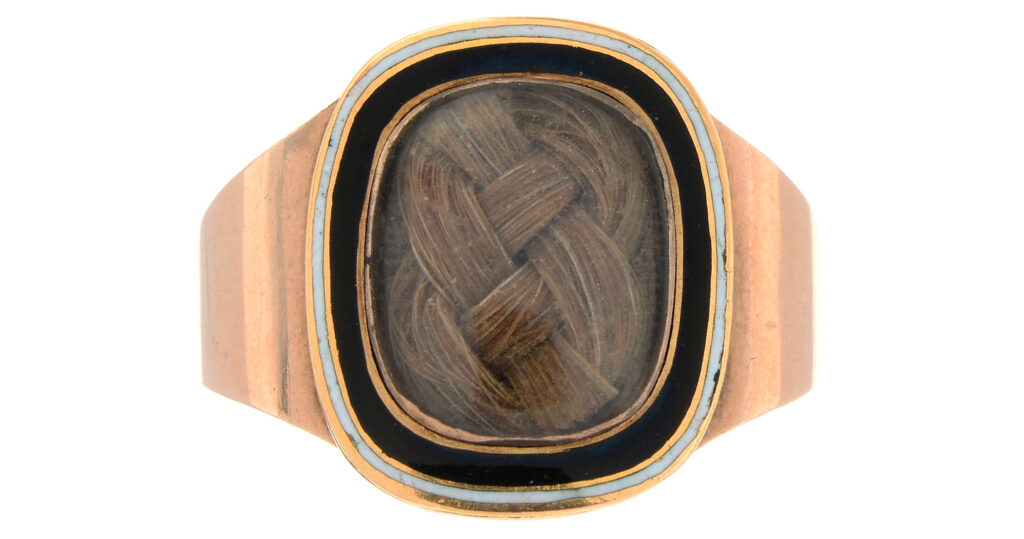Souvenir Ring Reveals Sentimentality

Jewellery given as as souvenir is a perfect way to offer a memory of a loved one to travel with when two people are apart. Giving a gift as a token of memory is a primal element of the human condition
In French, ‘Souvenir’ translates to ‘memory’, of which this memorial ring clearly is. Auguste Louise Stammler died on the 25th of November, 1837, yet this ring holds the memory of Auguste as a secret. Hidden inside the interlocking plates is the exquisitely written memorial dedication to her. Its calligraphy and design of the highest quality, which pairs beautifully with the design of the external pieces of the ring.
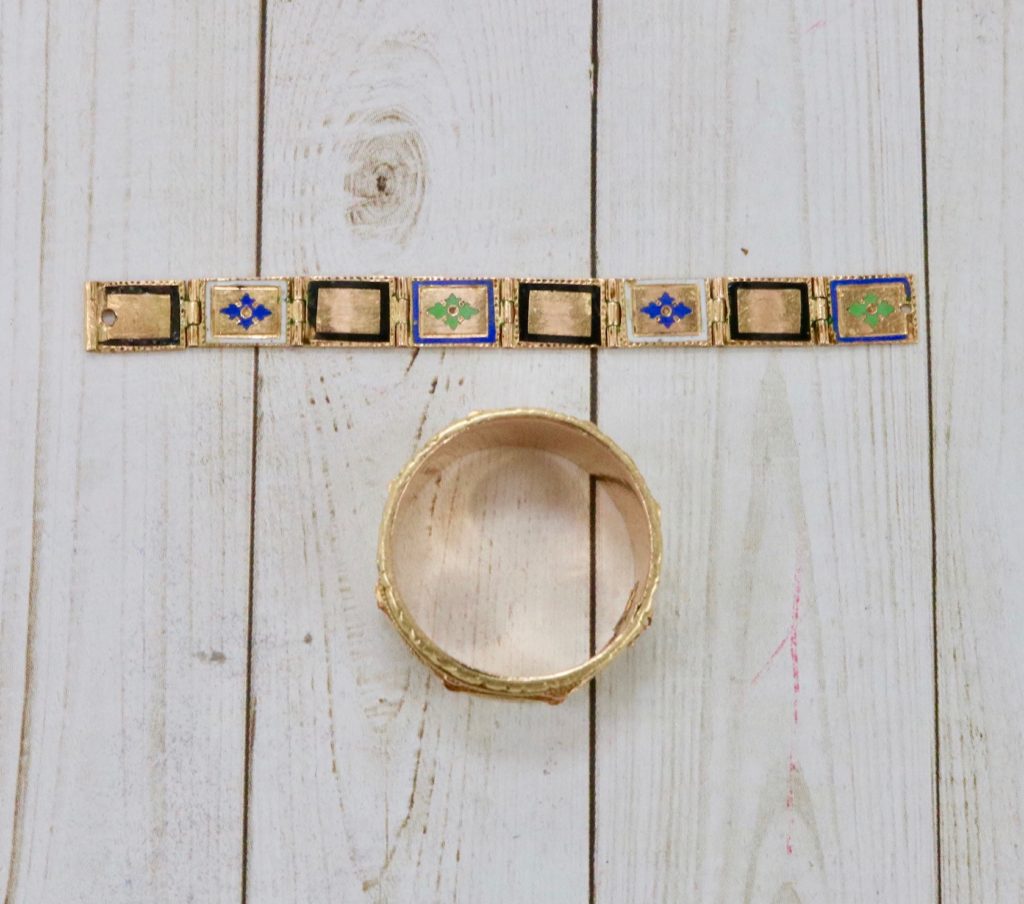
Its most remarkable element are the plates themselves. As the construction of rings becomes more delicate, the skill of the goldsmith to create these pieces rises. In this ring, the highest level of detail and quality are used. Industrial revolution processes and machine turning aided in producing higher levels of detail into jewellery production, but having the linkages in this ring shows a skill of the highest order. Its delicate connections need to balance with the curvature of the ring itself, with only one being slightly off to prevent it from closing on the clasp.
The ring is not a large one, making its construction even more detailed. On one side, the ring reads ‘SOUVENIR’ and on the other, blue, white, black and green enamelled patterns. Note how each don’t align in a direct straight line when unraveled, yet when clasped around the ring, they align with the ring’s circumference. Having these reversible is an impressive display of goldsmithing and design.

From this point in the 1830s, mourning and sentimental jewel were produced in higher volume. The Hallmarking Act of 1854 allowed for lower grade alloys, which led to lighter and more adaptable jewels to contemporary technologies and materials, such as photography and hair.
As these deigns were standardised through established jewellers, such as John Brogden, many jewels could cross the continent through catalogues and be produced in countries with established retailers. The United States, Australia, South Africa and anywhere with established colonies that produced revenue encouraged emigration of talent. The Gold Rush of 1851 in Ballarat, Australia, offered a place for goldsmiths to relocate and produce jewels from the gold.
Where there were people, there is love and loss. Sentimentality in the 19th century built a culture around sentimental gifts, such as the giving of woven hair and cheaper sentimental jewels in the designs of the popular floriography movement.
Various international gold rushes of the 19th century were important to capitalise on the wealth of the country that was discovering and mining it. The California Gold Rush of 1848-1855 expanded the reach of the United States and led to goldsmiths finding new wealth in areas that had previously been not as lucrative.
For a ring like this to be produced in France, the 1830s offered access to gold from the Parisian banks that worked internationally to accept incoming gold. The Banque de Franc was established in 1800, which was a federal establishment commissioned to produce national currency. A gold franc containing 290.034 of fine gold was established in 1803, named the Franc germinal, giving support to French currency and the jewels that could be produced from it. French jewels were constantly produced at a level of high quality in gold, but the populace didn’t offer the demand that was in England, due to the French Terror, subsequent Napoleonic Wars and the instability of the time.
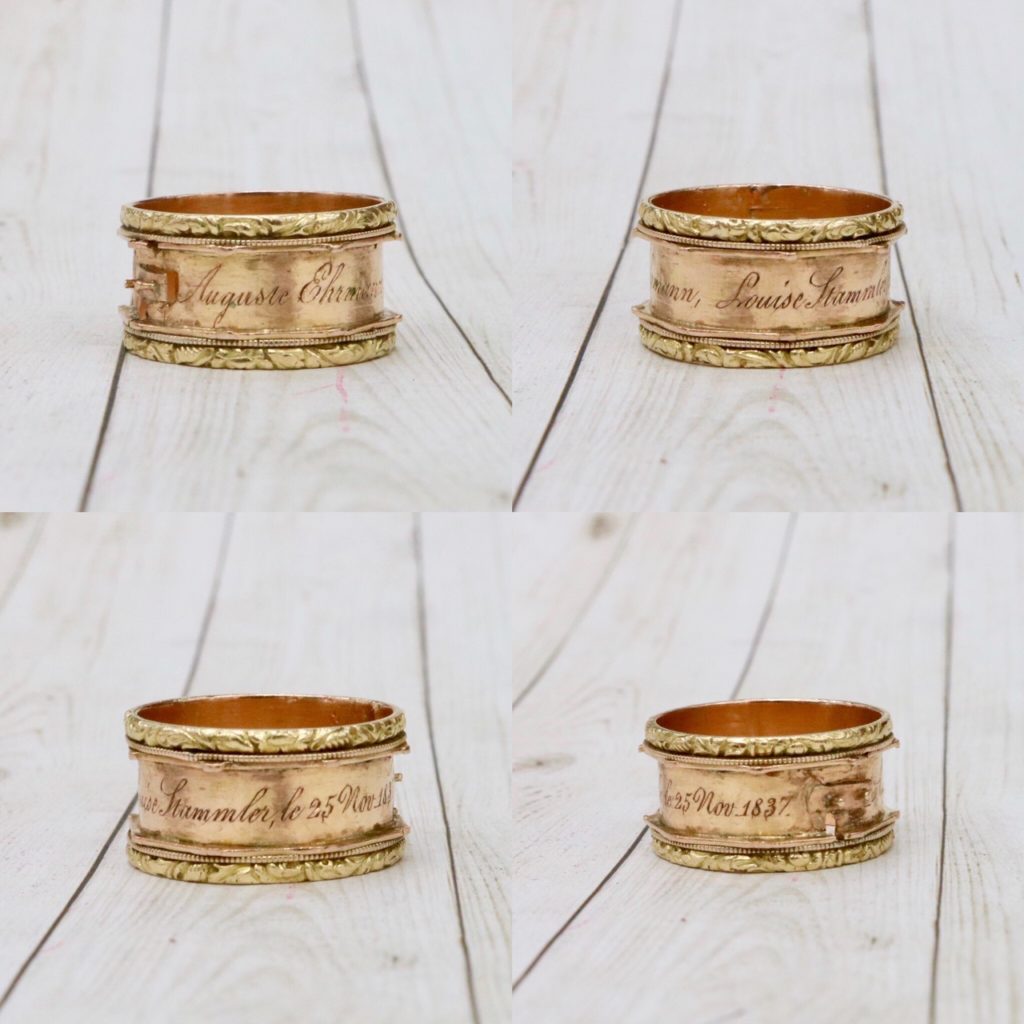

The buckle/garter motif was an especially popular design, with its continuous band of eternity, locked and entwined within itself. Placing hair inside the buckle lasted until the turn of the 20th century, as it was cheap to produce and highly sentimental.
Unusual construction techniques that followed on from this had their development in the 1837 Stammler ring. As can be seen here, an opening compartment reveals the ‘souvenir’ element of the ring; the hair of the loved one.

Especially by the 1870s, the designs of these rings became more standardised, so their sentimental value could be changed in the adaption of a different bezel or central element. Love hearts, hands, birds, shields and all manner of designs could be taken from catalogues and mixed and matched with other styles.
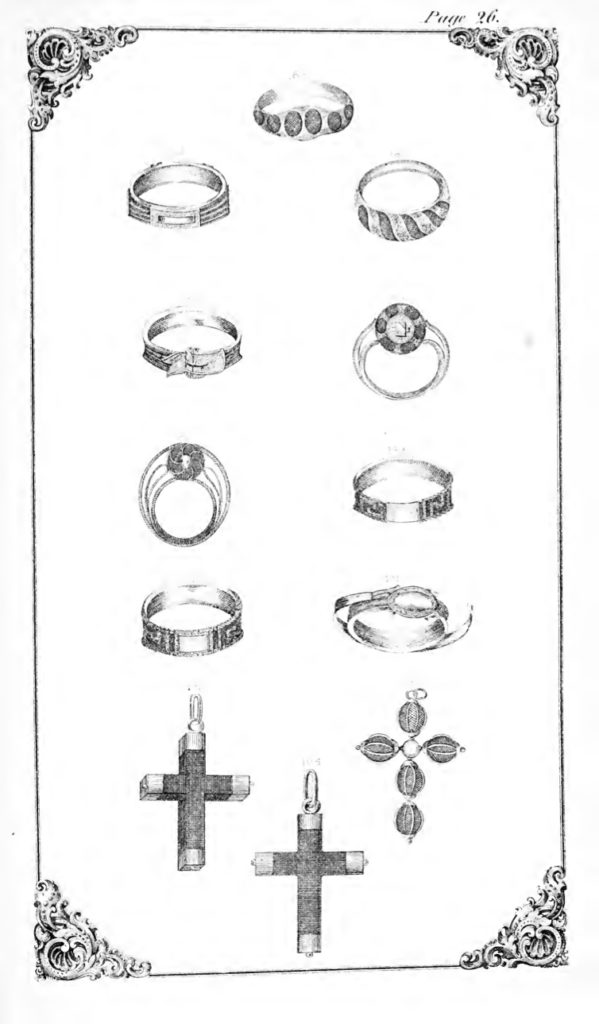
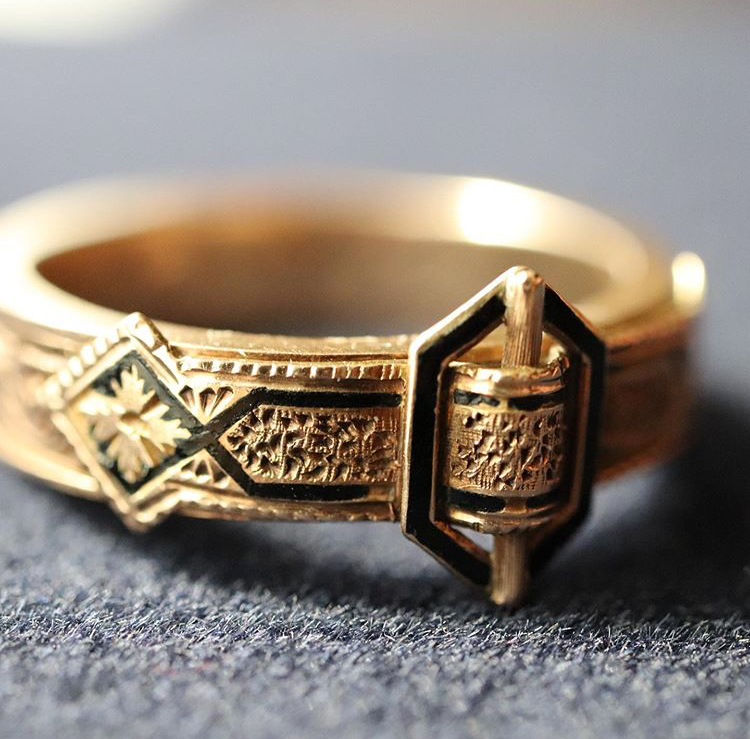
In this ring from 1874, “mother’s” hair is placed within another compartmental ring, which opens at at 180 degree hinge to reveal its hair inside. This ring makes exquisite use of the buckle motif and the construction seamlessly closes the ring, so that the hair is completely hidden. The end of the belt forms over the band, with the floral pattern inlay looking as if the ring is uniform.
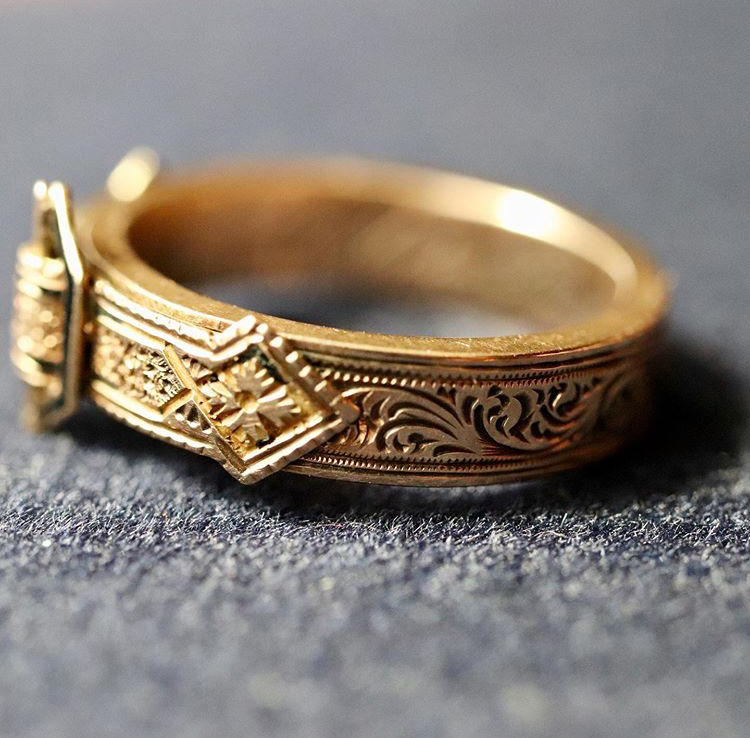
Unusual constructions in the late 19th century weren’t relegated to simply the hinge. This particular ring has a sliding open compartment that reveals the hair inside. What is interesting about these rings is how they appealed to the value of the wearer. These rings would unlikely have been used in the modern context of wearing jewels. Daily life is vastly different and the sentiment of giving these jewels does not mean that they had to be worn on a daily basis, but they were often keepsakes, which is why many exist in such fine condition today.
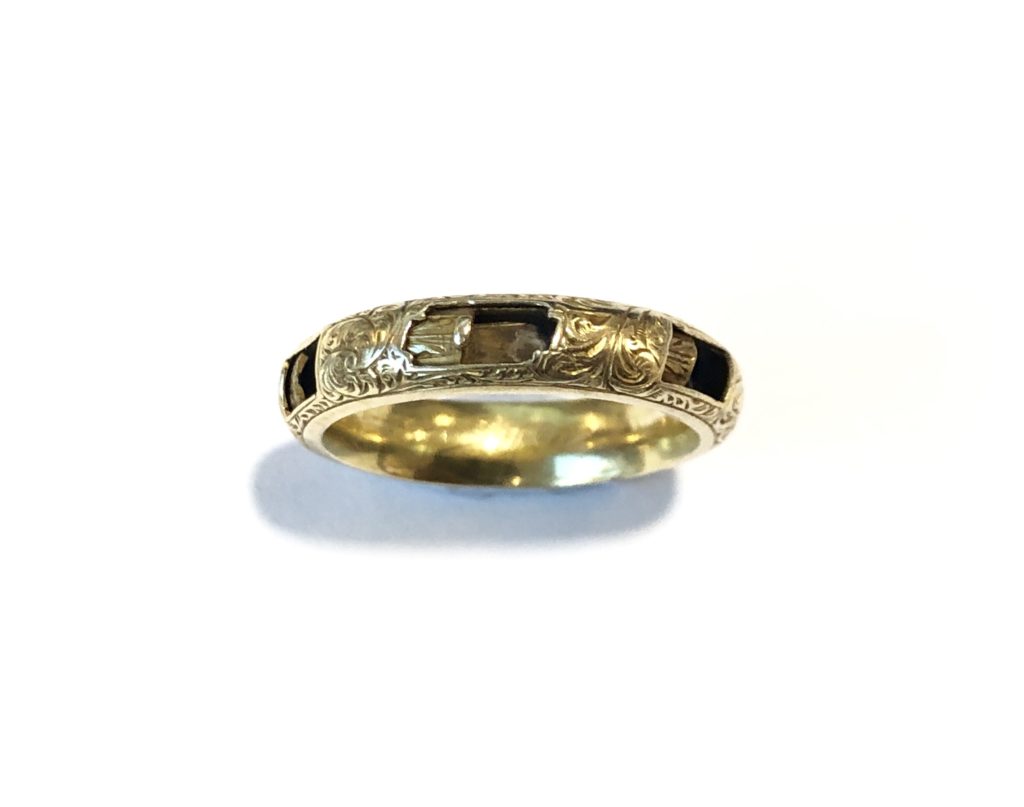
Hiding the hair, however, away from viewing of other people, is a charming way to keep the relationship of two people a personal one and not one that needs to be on display. Even in the case of the Stammler ring, both the name and the sentiment of ‘SOUVENIR’ can be kept hidden, so that the ring is just a fashionable one.
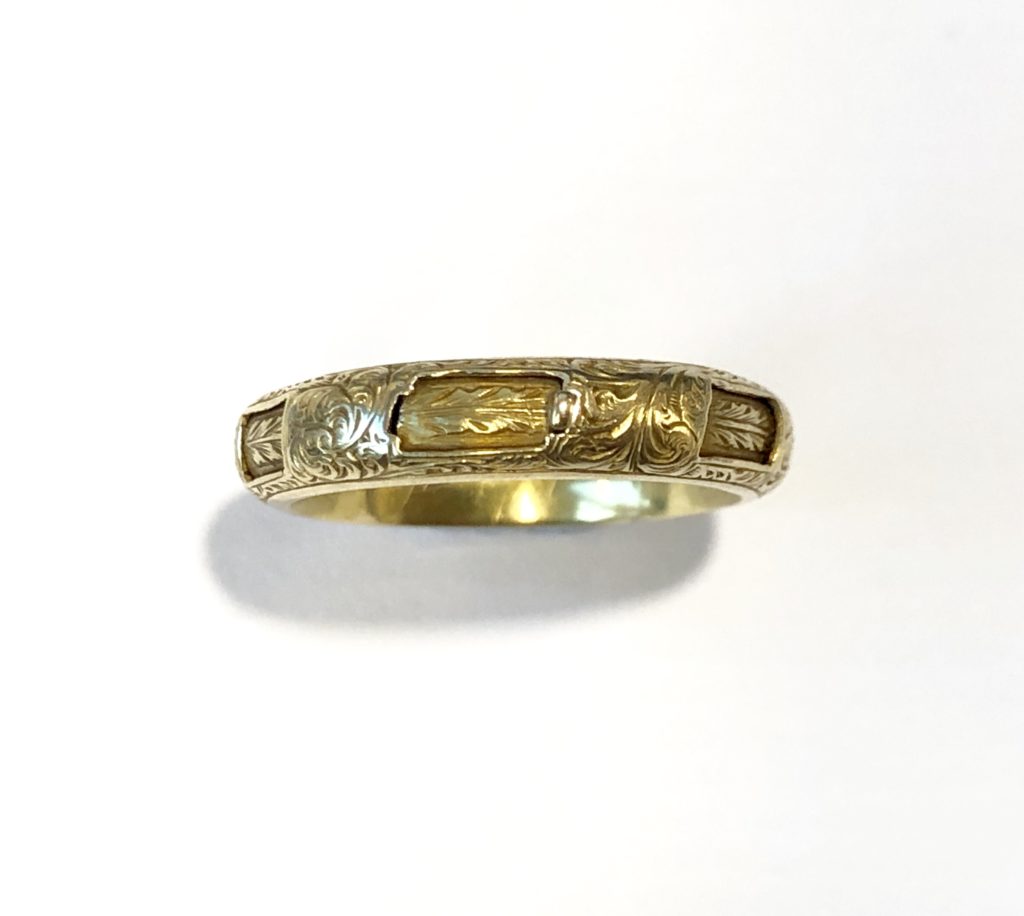
Style
In the design of this ring, one can see the essential elements that had developed from the turn on the 19th century to become the predominate styles for the c.1840 period. Its highly detailed edging to the band, showing floral elements, takes its cue from the Baroque period, while the overarching style is Gothic Revival. The Gothic Revival was prominent in adapting elements from the Medieval period and representing Catholic elements. These were important in the context of the time, as it reflected a time of piety; a time when society didn’t have the excess of the late 18th and early 19th centuries. It was important to build the Christian family values of the second half of the 19th century, values which promote political and familial stability. France, being Catholic, utilised these elements, but in England, the Roman Catholic Relief Act / Catholic Emancipation Act of 1829 allowed for Catholics to sit in parliament in Westminster. Much of this existed from the anti-Catholic sentiment in the 17th century, which protected the Crown from having the House of Stuart reintroduce a Catholic monarchy. The relaxation of these values shows higher stability in the crown and an effort to create stability politically.
The 1830s made an effort to swing back to the ideals of the High Church and Anglo-Catholic self-belief. This was a time when heavy industry was on the rise and modern society (as we consider it today) was established, a time of radical change that challenged pre-existing ideals of society.
Though there had been growing small scale social mobility from the late 17th century, the late 18th and early 19th centuries saw the middle classes having the opportunity to promote through society with the accumulation of wealth.
Augustus Welby Northmore Pugin, a designer, architect and convert to Catholicism, saw this industrial revolution as a corruption of the ideal medieval society. Through this, he used Gothic architecture as a way to combat classicism and the industrialisation of society, with Gothic architecture reflecting ‘proper’ Christian values. Ideologically, Neoclassicism (the style of c.1760-1820) was adopted by liberalism; this reflecting the self, the pursuit of knowledge and the freedom of the monotheistic ecclesiastical system that had controlled Western society throughout the medieval period. Consider that Neoclassicism influenced thought during the same period as the American and French revolutions and it isn’t hard to see the parallels. The Gothic Revival would, in effect, push society into the paradigm of monarchy and conservatism, which would dominate heavily throughout the 19th century and establish many of the values that are still imbued within society today.
Seen in mourning jewels from the early 19th century, the Gothic Revival style has several elements that adapted the style from previous styles of jewellery. Black enamel bands are one of the fundament design styles of mourning jewels since their early-modern inception. They are simple ways of projecting grief based upon one sentiment and a colour. Black enamel, representing death, with a dedication to the person, or a message such as ‘IN MEMORY OF’ are clear denotations of death. They can be produced in high numbers in a series of sizes, which make them the ideal ring for grief.
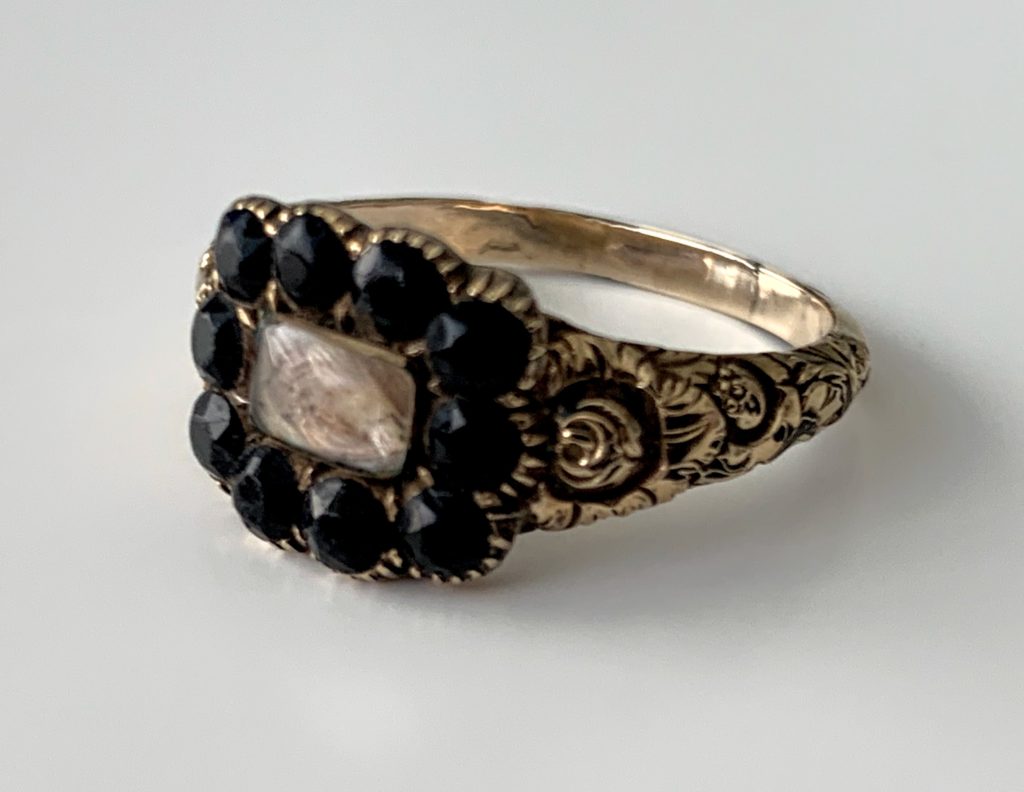
As this ring shows, style was of such importance. It adapted from the Baroque, to the Rococo, to the Neoclassical and now the Gothic Revival style. As seen in the ring from c.1820, it has the floral banding to the edge of the band. This reflected in contemporary mourning and sentimental jewels, as it is typical to overtake the shoulders of the band and the surround of the bezel with the similar design.
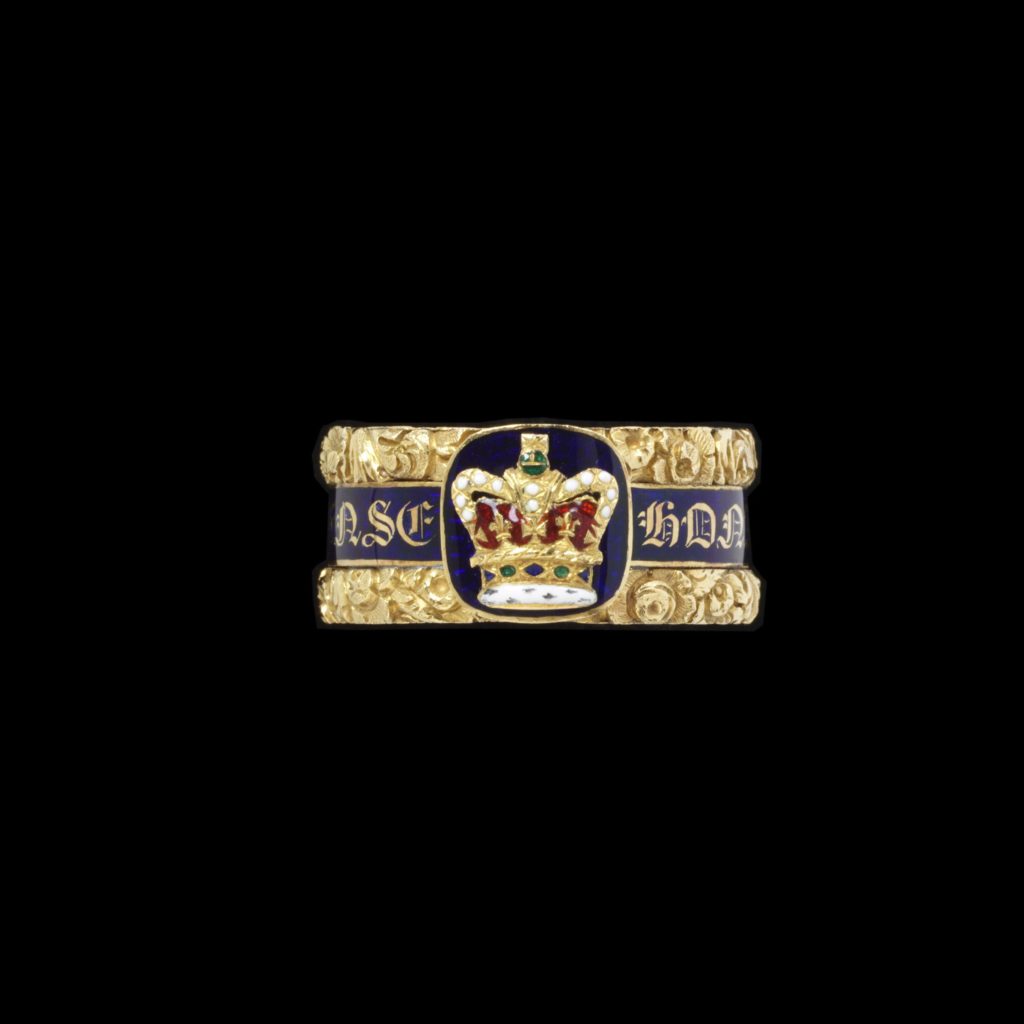
As with all styles that became popular through the early-modern period, it is always best to look at the styles introduce by the monarchy. They had the money and influence to travel, bring back new styles or afford artisans to craft new styles for them. These styles set a monarch apart and made them aspirational towards lower classes. When a monarch has a jewel dedicated to their passing, it is interesting to see its design. This ring for George III has the following description:
“Enamelled gold commemorative ring, the squared oval bezel with the royal crown enamelled in red and white. The hoop with a chased floral border. The central band inscribed in gold letter reserved on blue HONI. SOIT. QUI. MAL. Y. PENSE. and inscribed inside GEO: 3rd born 4 June 1738/ Acceeded 25 Oct 1760/ Married 8 Sep 1760/ Crowned 22/ died 20 Jan 1820 Aged 81.. Maker’s mark SW and London Hallmarks for 1819-20.”
It bares all the styles that are elements of the crown. The blue enamel, representing royalty, the French statement of the Order of the Garter (translating to “May he be shamed who thinks badly of it”) and the royal crown. Of note are the similarities to the 1837 Stammler ring. The colour of the band with the German inspired Gothic lettering would be the catalyst for jewels to come, of all levels and cost of construction.
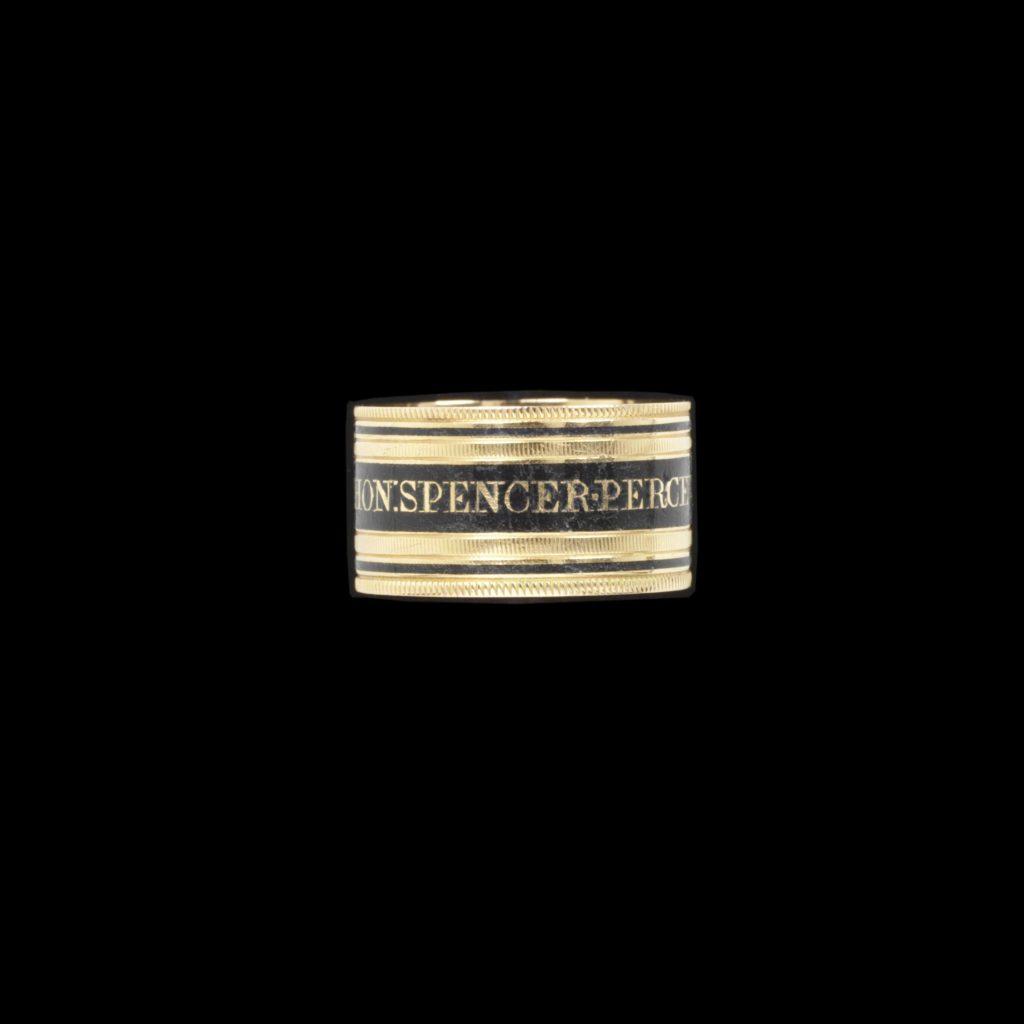
But what was the style that the Gothic Revival adapted? In this ring for Spencer Percival, who passed away on the 11th of May, 1812 at the age of 49, a ring of modest design provides the perfect template for what the following style would embellish. There is the slightest element of machine turning to the interior and edge of the band, which would adapt into the heavy, floral embellishments. The interior is the black enamel of the band, with the name and date of death. Origins of this stretch back to the 17th century and this is the late Neoclassical period’s version of it. Clearly, it is a ripe template for design to change its elements, yet still retain is memorial message.
In the following jewel, one can see how the elements of the George III ring adapted into a more humble and accessible design. The description is as follows:
“The black enamel of this ring indicates that the deceased, Esther Ferriman, was married. Esther was born in 1775 and married George Ferriman. She died aged 42 at Kingston-upon- Thames, Surrey. Marks inside the ring show that it was made in York in 1824-5, a few years after Esther’s death (1817).”
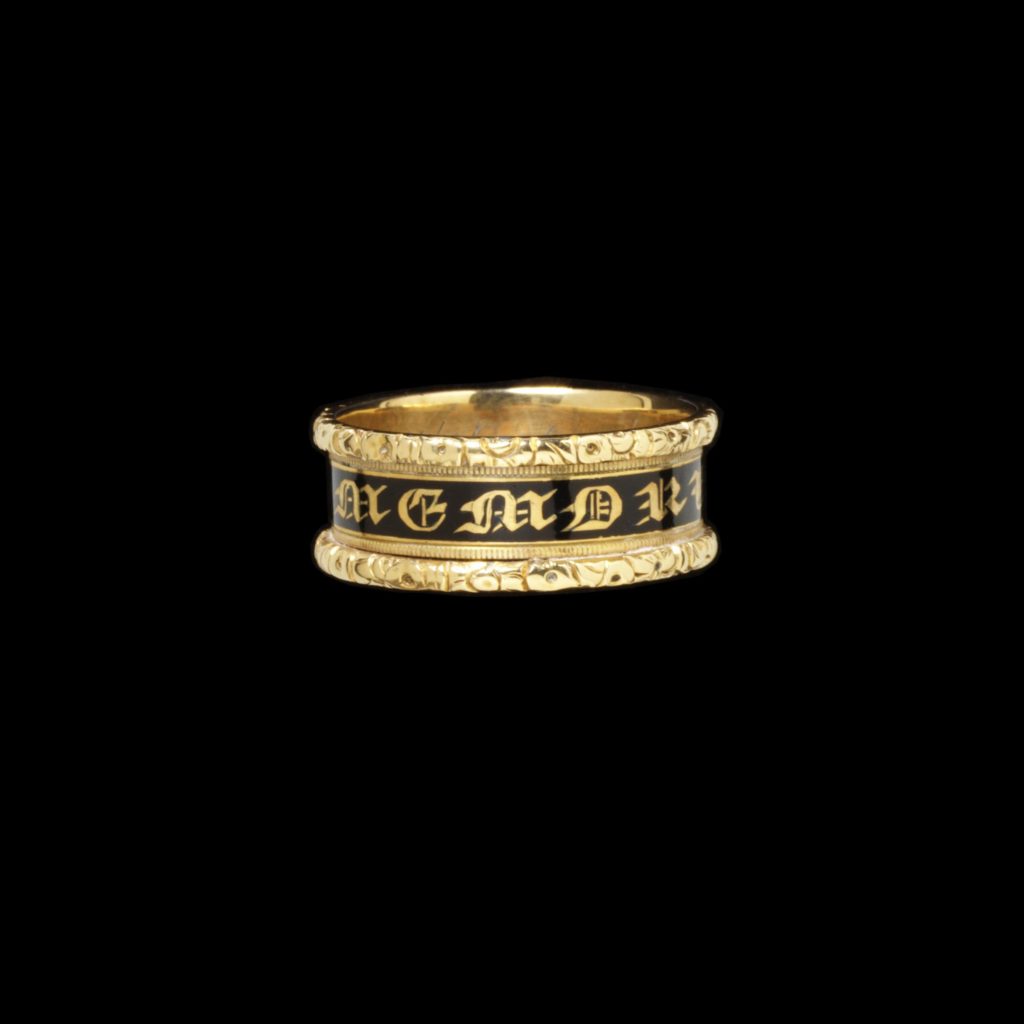
It is a posthumous ring, which explains how well it adapts the popular styles.The floral elements are all seen in the band of the ring and notice the machine turned lines inside, which marry together with the style of the Percival ring. Its strongest Gothic Revival element is the font of the type, which has its very strong ‘IN MEMORY OF’ statement overwhelming the design of the ring. These were often constructed of two pieces, with an interior and and exterior band, which were fused together. The inside could be inscribed for the deceased and the exterior with enamel was not as tailored as earlier rings, which had the name of the deceased on the exterior.
Courtesy @alphaomedgajewelry




